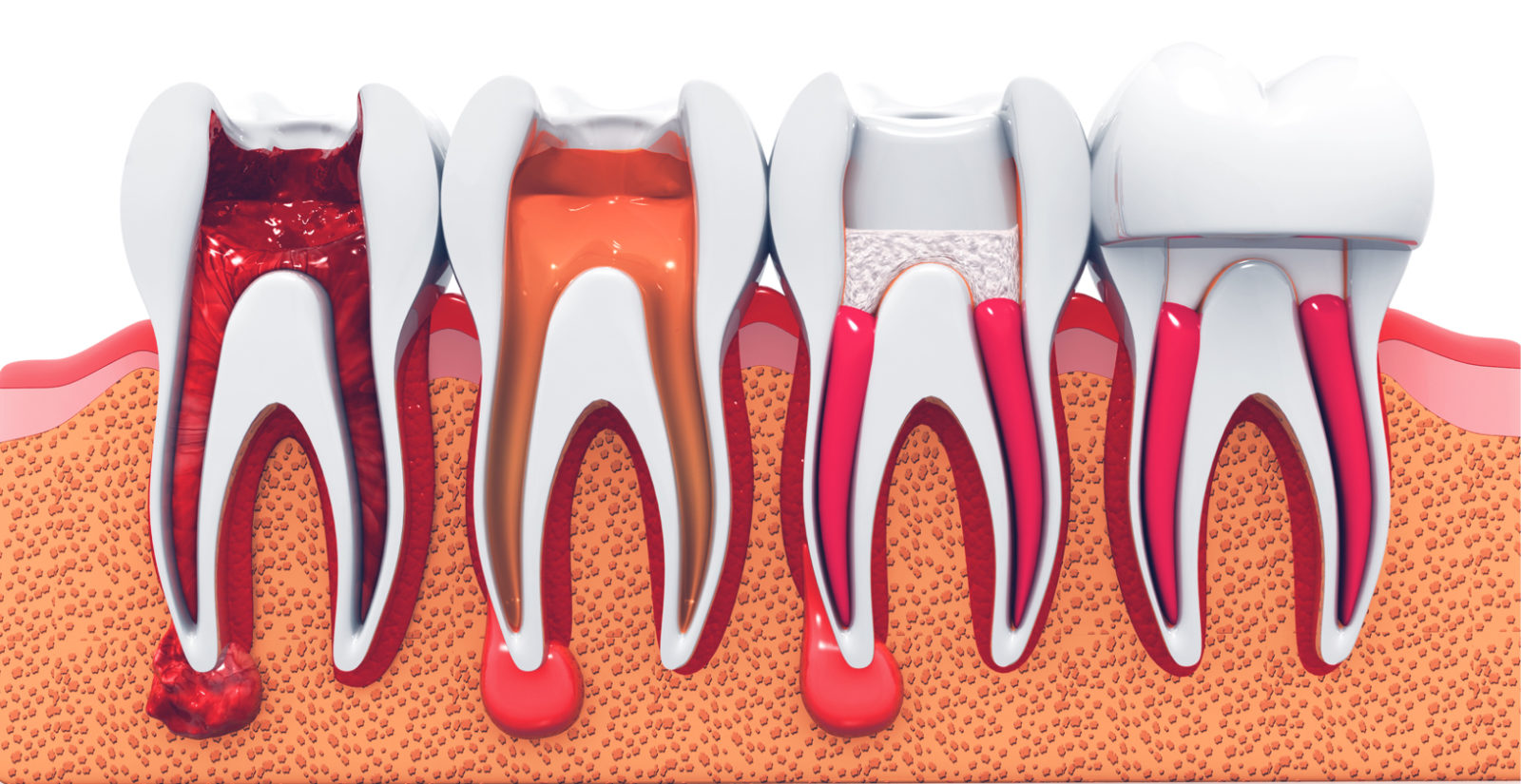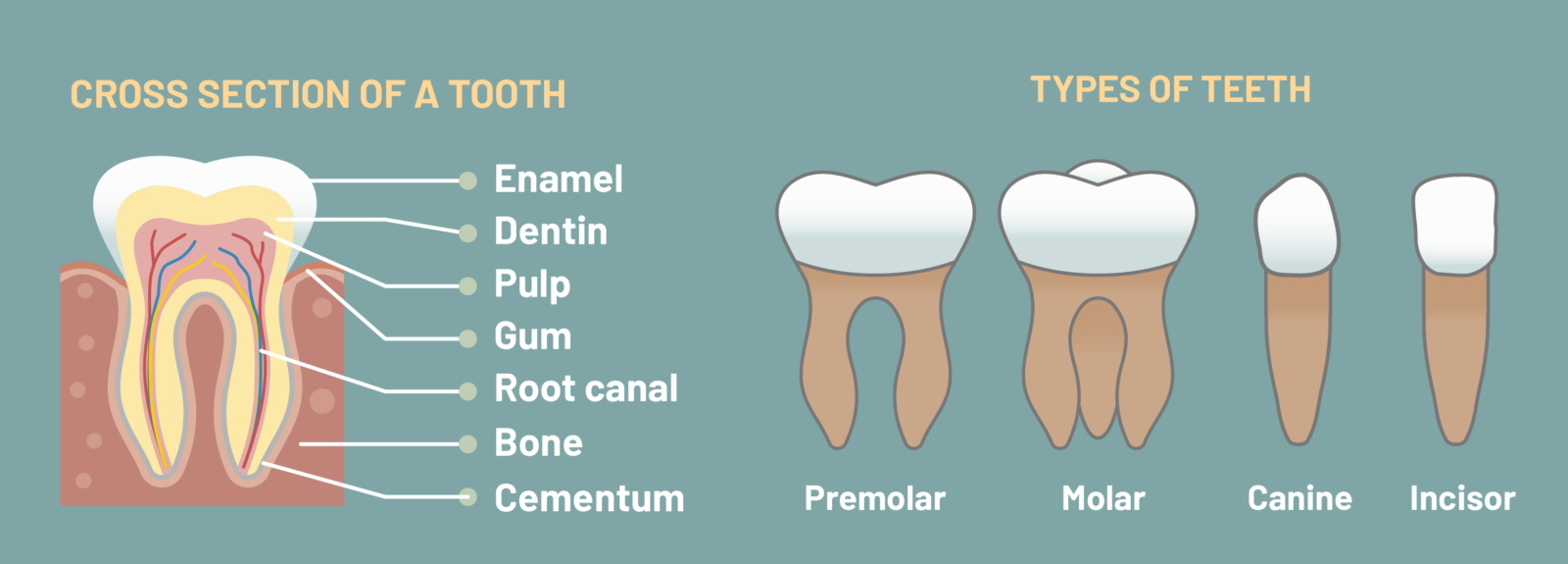Root canal therapy, also called endodontic treatment is frequently recommended when someone has a severe toothache and might be in significant discomfort. Consequently, it can be associated with feelings of pain, but it shouldn’t be a scary procedure. Far from being painful, root canal treatment should not feel any worse than having a filling. The procedure is more intricate and does take longer to complete, and it might take a few days afterwards for the tooth to settle down fully. However, it helps to relieve pain and discomfort and can save a badly infected tooth from extraction.
What is a Root Canal?
A root canal treatment is a procedure that preserves and restores a tooth after the dental pulp becomes infected or inflamed. The dental pulp is right in the centre of the tooth and is a collection of soft tissues containing the tooth nerve, blood vessels and connective tissues. These tissues extend into the root canals of a tooth, in the tooth roots.
When you have a root canal, your dentist accesses the dental pulp, carefully removing all the infected or inflamed soft tissues. They clean out the root canals using specially shaped files before disinfecting the area, filling it and sealing it permanently. Treatment is completed with a dental crown fitted over the tooth, preventing further damage and infection to the tooth and also strengthening the tooth.
How Do I Know If I Need a Root Canal?
A tooth can become infected or inflamed if you have a deep cavity that isn’t filled or have lost a filling. Infection can also occur if a tooth is chipped or cracked and not repaired. Even a slight crack in a tooth can open up when you bite down. These situations allow harmful bacteria to enter the tooth, causing infection. Sometimes a tooth might not be infected, but the dental pulp becomes inflamed, swollen and painful. Inflammation can occur if you take a knock to the mouth, even if it doesn’t crack or damage the tooth visibly.
There are several signs that you might need a root canal, including:
Toothache
Most people will visit a dentist because of toothache. The pain may only be present when you eat or can be consistent and throbbing. It can worsen if you eat anything very hot or cold. The pain might seem to disappear, but this doesn’t mean the infection has gone as it could be that the tooth nerve has simply died. Although the nerve is dead, the infection remains and can worsen.
Swollen and Tender Gums
The inflammation and infection can cause gum swelling, and your gums might feel tender to touch. Sometimes a pimple will develop on the gum’s surface, caused by pus building up in the infected tooth root and which can be a sign of a dental abscess.
Darkening Tooth or Gum
As the nerve in the tooth dies, the tooth can change colour, darkening and turning grey as it loses its blood supply. The infection can cause the gum around the tooth to darken.
Facial Swelling
If you have a severe infection, you may have facial swelling, possibly accompanied by a fever and feeling very unwell. If you develop these symptoms, you must seek emergency dental care without delay. Rarely, a severe tooth infection can also become life-threatening, so please don’t take this risk with your health.
What to Expect When You See a Dentist for Toothache?
Tandara Dental Centre makes every effort to see patients in pain as soon as possible to provide a speedy and accurate diagnosis and treatment to help them feel better. When you come to see us, we will ask about your symptoms, gently examine the tooth, and take dental x-rays. These x-rays show us the extent of the infection and damage to the tooth. They also show us the number and shape of your root canals, which is helpful when planning your treatment.
If the infected tooth is right at the front of your mouth, it will only have a single root and one root canal, whereas a larger back tooth can have several roots, each with a root canal that must be cleaned during treatment. We will also ask you about your dental and medical history before recommending a suitable solution. Hopefully, we will be able to provide root canal therapy to save the tooth. Preserving your natural teeth is always our preferred solution.
How Will Root Canal Therapy Help to Save a Tooth?
When the dental pulp is infected or severely inflamed, it cannot recover and must be removed to prevent the infection from spreading. The only alternative is to remove the tooth. By performing root canal therapy, we can eliminate the infection and inflammation and protect and preserve the tooth by covering it with a dental crown. Often, a root treated tooth will last for many years after treatment.
Why Will I Need a Dental Crown After Root Canal Therapy?
Once a tooth has received root canal therapy, it is non-vital as the living part of the tooth, the nerve is removed. While an adult tooth can survive perfectly well without the nerve, removing it can make the tooth more brittle, so we need to protect it with a dental crown. Additionally, a tooth that has become infected may have lost a substantial part of its original structure to decay and cannot be repaired with a filling.
What to Expect When You Have a Root Canal?
Usually, root canal therapy takes several appointments to complete. First, we will numb the tooth before creating an opening in it to reach the dental pulp. Next, we thoroughly clean out the nerve tissues, using special files to clean and shape the root canals. The tooth is thoroughly disinfected, and we may put medications inside to eliminate any remaining bacteria before sealing the tooth with a temporary filling. The tooth is then left for three weeks to settle down.
When you return, we remove the temporary filling and disinfect the tooth again before placing more medication. After another three weeks, we will see you again, and if we are sure all the infection is eliminated, we will place a permanent filling of gutta-percha inside the tooth to seal it then and make a crown to cover the tooth entirely. Treatment is complete once your new crown is fitted.
What to Expect Immediately After Root Canal Therapy?
After your initial treatment, the tooth might feel a bit sensitive, but any severe toothache should quickly disappear. If you have any discomfort, over the counter painkillers should minimise these feelings, or we can prescribe something if your tooth infection was especially severe. Usually, any sensitivity will disappear within a day or two. It is best to avoid biting on the tooth during this time in case you dislodge the temporary filling or crack the tooth. When we fit your crown, your tooth should feel completely comfortable, allowing you to bite and chew with confidence.
Caring for Your Tooth After Root Canal Therapy
Once treatment is complete, ensure you continue to brush and floss thoroughly, as this will help prevent further infections. We can check the condition of the tooth and the crown during your regular checkups here at Tandara Dental Centre.
If you suspect you have a problem with a tooth, please come and see us at Tandara Dental Centre as soon as possible. A home toothache remedy will not treat the cause of the problem, and the more quickly we can treat your tooth, the better the chance we can save it, and of course, provide toothache relief.










